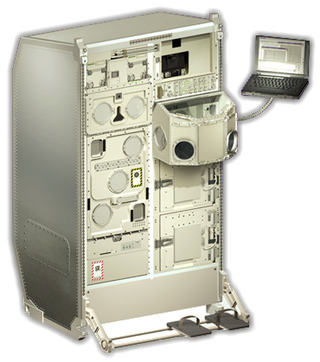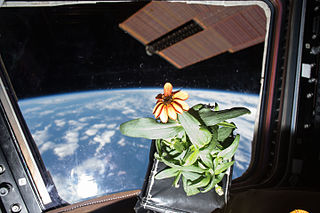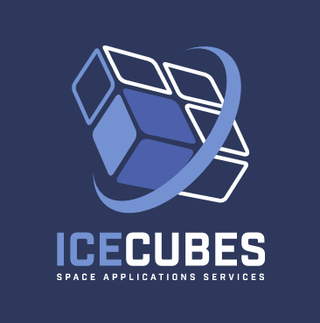Related Research Articles

Spacelab was a reusable laboratory developed by European Space Agency (ESA) and used on certain spaceflights flown by the Space Shuttle. The laboratory comprised multiple components, including a pressurized module, an unpressurized carrier, and other related hardware housed in the Shuttle's cargo bay. The components were arranged in various configurations to meet the needs of each spaceflight.

Space manufacturing is the production of tangible goods beyond Earth. Since most production capabilities are limited to low Earth orbit, the term in-orbit manufacturing is also frequently used.

Biolab is a single-rack multi-user science payload designed for use in the Columbus laboratory of the International Space Station. Biolab support biological research on small plants, small invertebrates, microorganisms, animal cells, and tissue cultures. It includes an incubator equipped with centrifuges in which the preceding experimental subjects can be subjected to controlled levels of accelerations.

The International Space Station is a platform for scientific research that requires one or more of the unusual conditions present in low Earth orbit. The primary fields of research include human research, space medicine, life sciences, physical sciences, astronomy and meteorology. The 2005 NASA Authorization Act designated the American segment of the International Space Station as a national laboratory with the goal of increasing the use of the ISS by other federal agencies and the private sector.
m ELIPS - European Programme for Life and Physical Sciences in Space and applications utilising the International Space Station started in 2001 and was intended to cover the activities for the following 5 years. This Microgravity Programme at the European Space Agency (ESA) is an optional programme, with currently 17 ESA member states participating. The ELIPS programme prepares and performs research on the International Space Station, and other uncrewed mission platforms like Sounding Rockets, in fundamental and applied life and physical sciences. ELIPS is the continuation of the earlier European microgravity programmes EMIR 1&2, and the Microgravity Facilities for Columbus, MFC.

The NASA Launch Services Program (LSP) is responsible for procurement of launch services for NASA uncrewed missions and oversight of launch integration and launch preparation activity, providing added quality and mission assurance to meet program objectives. LSP operates under the NASA Space Operations Mission Directorate (SOMD).

SpaceX CRS-4, also known as SpX-4, was a Commercial Resupply Service mission to the International Space Station (ISS), contracted to NASA, which was launched on 21 September 2014 and arrived at the space station on 23 September 2014. It was the sixth flight for SpaceX's uncrewed Dragon cargo spacecraft, and the fourth SpaceX operational mission contracted to NASA under a Commercial Resupply Services contract. The mission brought equipment and supplies to the space station, including the first 3D printer to be tested in space, a device to measure wind speed on Earth, and small satellites to be launched from the station. It also brought 20 mice for long-term research aboard the ISS.

Nanoracks LLC is a private in-space services company which builds space hardware and in-space repurposing tools. The company also facilitates experiments and launches of CubeSats to Low Earth Orbit.

The growth of plants in outer space has elicited much scientific interest. In the late 20th and early 21st century, plants were often taken into space in low Earth orbit to be grown in a weightless but pressurized controlled environment, sometimes called space gardens. In the context of human spaceflight, they can be consumed as food and/or provide a refreshing atmosphere. Plants can metabolize carbon dioxide in the air to produce valuable oxygen, and can help control cabin humidity. Growing plants in space may provide a psychological benefit to human spaceflight crews. Usually the plants were part of studies or technical development to further develop space gardens or conduct science experiments. To date plants taken into space have had mostly scientific interest, with only limited contributions to the functionality of the spacecraft, however the Apollo Moon tree project was more or less forestry inspired mission and the trees are part of a country's bicentennial celebration.

BioServe Space Technologies is a research institute within the University of Colorado in Boulder, Colorado. Since its foundation in 1987 it focuses on developing microgravity life science research and hardware. Its current Chief Scientist is Prof. Louis Stodieck and the Center Director is Ms. Stefanie Countryman BioServe has designed, built and flown over 50 different payloads on over 85 space flight missions including the Space Shuttle, ISS, MIR, Soyuz, and Progress and recently the SpaceX's Dragon capsule and Orbital's Cygnus spacecraft.
The Student Spaceflight Experiments Program (SSEP) provides an opportunity for student groups from upper elementary school through university to design and fly microgravity experiments in low Earth orbit (LEO). SSEP is a program of the National Center for Earth and Space Science Education, the Arthur C. Clarke Institute for Space Education, and the private space hardware company NanoRacks. SSEP operates under a Space Act Agreement between the sponsoring organizations and NASA, allowing the International Space Station (ISS) to be utilized as a national laboratory.

The Cold Atom Laboratory (CAL) is an experimental instrument on board the ISS, which launched in 2018. It creates an extremely cold microgravity environment in order to study behaviour of atoms in these conditions.
DreamUp PBC is a Public-benefit corporation that offers space-based educational activities. DreamUp is a spin-off and sister company of Nanoracks LLC, a private spaceflight company. Nanoracks gives DreamUp access to research opportunities on the U.S. National Lab on board the International Space Station.

NASA's Rodent Research Hardware System provides a research platform aboard the International Space Station for long-duration experiments on rodents in space. Such experiments will examine how microgravity affects the rodents, providing information relevant to human spaceflight, discoveries in basic biology, and knowledge that can help treat human disease on Earth.
The ISS U.S. National Lab, commonly known as the ISS National Lab, is a U.S. government-funded national laboratory established on 30 December 2005 by the 2005 NASA Authorization Act. With principal research facilities located in the United States Orbital Segment (USOS) of the International Space Station (ISS), the Laboratory conducts research in life sciences, physical sciences, technology development and remote sensing for a broad range of academic, government and commercial users. Of the 270 payloads that the Center for the Advancement of Science in Space (CASIS) has sent to the ISS, 176 have been for commercial companies including Merck & Co., Novartis, Eli Lilly and Company, Hewlett Packard Enterprise, Honeywell, and Procter & Gamble.

The International Commercial Experiment Cubesservice is a commercial service that offers access to space for research, technology and education.

NG-13, previously known as OA-13, was the fourteenth flight of the Northrop Grumman robotic resupply spacecraft Cygnus and its thirteenth flight to the International Space Station (ISS) under the Commercial Resupply Services (CRS-1) contract with NASA. The mission launched on 15 February 2020 at 20:21:01 UTC after nearly a week of delays. This is the second launch of Cygnus under the CRS-2 contract.

SpaceX CRS-21, also known as SpX-21, was a Commercial Resupply Service mission to the International Space Station which launched on 6 December 2020. The mission was contracted by NASA and was flown by SpaceX using a Cargo Dragon 2. This was the first flight for SpaceX under NASA's CRS Phase 2 contract awarded in January 2016. This was also the first Cargo Dragon of the new Dragon 2 variant, as well as the first Cargo Dragon flight that was docked at the same time as a Crew Dragon spacecraft. This mission used Booster B1058.4, becoming the first NASA mission to reuse a booster previously used on a non-NASA mission. This was also first time SpaceX launched a NASA payload on a booster with more than one previous flight.

NG-15, previously known as OA-15, was the fifteenth launch of the Northrop Grumman robotic resupply spacecraft Cygnus and its fourteenth flight to the International Space Station (ISS) under the Commercial Resupply Services (CRS) contract with NASA. The mission launched on 20 February 2021 at 17:36:50 UTC. This is the fourth launch of Cygnus under the CRS-2 contract.

SpaceX CRS-24, also known as SpX-24, was a Commercial Resupply Service mission to the International Space Station launched on 21 December 2021, at 10:07:08 UTC. The mission is contracted by NASA and is flown by SpaceX using a Cargo Dragon. This is the fourth flight for SpaceX under NASA's CRS Phase 2 contract awarded in January 2016.
References
- ↑ Rainey, Kristine (2015-04-01). "National Laboratory". NASA. Retrieved 2018-12-20.
- 1 2 3 4 "NASA's Management of the Center for the Advancement of Science in Space" (PDF). 2018-01-11.
- 1 2 3 "Research & Development - February 2018 - 4". digital.rdmag.com. Retrieved 2018-12-20.
- ↑ "Why Space?". pulse.embs.org. Retrieved 2018-12-20.
- ↑ Rettner, Rachael; August 12, Senior Writer |; ET, 2017 08:44am. "Next Stop for Parkinson's Disease Research: Outer Space". Live Science. Retrieved 2018-12-20.
- ↑ "Boston Startup Launches New Bone Glue To Space". 2015-11-03. Retrieved 2018-12-20.
- 1 2 Wattles, Jackie (2018-08-05). "Why Goodyear and Delta Faucet are doing research in space". CNNMoney. Retrieved 2018-12-20.
- 1 2 Chase, Robert (2017-03-15). "Colorado Students Get Second Chance At Space" . Retrieved 2018-12-20.
- ↑ "First Commercial 3D Printer Successfully Installed on ISS". www.engineering.com. Retrieved 2018-12-20.
- ↑ "Surgical Robots in Space: Sci-Fi and Reality Intersect". pulse.embs.org. Retrieved 2018-12-20.
- ↑ "ISS National Lab FY2018 Metrics". www.issnationallab.org. Retrieved 2018-12-21.
- 1 2 3 4 5 "ISS U.S. National Laboratory". www.issnationallab.org. Retrieved 2018-12-20.
- ↑ "Earth Science and Remote Sensing Onboard the ISS National Lab". www.issnationallab.org. Retrieved 2018-12-20.
- ↑ "Houston, We Have a Problem". pulse.embs.org. Retrieved 2018-12-20.
- 1 2 3 "Education Initiatives Onboard the ISS National Lab". www.issnationallab.org. Retrieved 2018-12-20.
- 1 2 "Space Station Explorers". www.spacestationexplorers.org. Retrieved 2018-12-20.
- ↑ Vanni, Olivia (2018-09-16). "A Cambridge Startup Will Be Testing Astronauts' DNA on the Space Station".
- ↑ Gagne, Michael. "Fall River's Talbot students to conduct out-of-this-world tadpole experiment". The Herald News, Fall River, MA. Retrieved 2018-12-20.